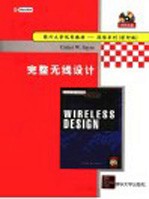
- 作 者:(美)塞杰(Sagre,C.W.)著
- 出 版 社:北京:清华大学出版社
- 出版年份:2004
- ISBN:7302102864
- 标注页数:547 页
- PDF页数:562 页
请阅读订购服务说明与试读!
订购服务说明
1、本站所有的书默认都是PDF格式,该格式图书只能阅读和打印,不能再次编辑。
2、除分上下册或者多册的情况下,一般PDF页数一定要大于标注页数才建议下单购买。【本资源562 ≥547页】
图书下载及付费说明
1、所有的电子图书为PDF格式,支持电脑、手机、平板等各类电子设备阅读;可以任意拷贝文件到不同的阅读设备里进行阅读。
2、电子图书在提交订单后一般半小时内处理完成,最晚48小时内处理完成。(非工作日购买会延迟)
3、所有的电子图书都是原书直接扫描方式制作而成。
Chapter 1.Wireless Essentials 1
1.1 Passive Components at RF 1
1.1.1 Introduction 1
1.1.2 Resistors 2
1.1.3 Capacitors 2
1.1.4 Inductors 4
1.1.5 Transformers 7
1.2.3 Transistors 1 7
1.2 Semiconductors 9
1.2.1 Introduction 9
1.2.2 Diodes 10
Contents 11
Preface 11
1.3.1 Introduction 26
1.3 Microstrip 26
1.3.2 Microstrip as Transmission Line 27
1.3.3 Microstrip as Equivalent Components 28
1.4 Transmission Lines 38
1.4.1 Introduction 38
1.4.2 Transmission Line Types 38
1.4.3 Transmission Line Issues 39
1.5 S-Parameters 39
1.5.1 Introduction 39
1.5.2 S-Parameter Measurement 43
1.6 Propagation 48
1.6.1 Introduction 48
1.6.2 Multipath 48
2.1.2 Fundamentals 51
2.1.1 Introduction 51
2.1 Amplitude Modulation 51
Chapter 2.Modulation 51
2.1.3 Power Measurement 56
2.1.4 Disadvantages 57
2.2 Frequency Modulation 57
2.2.1 Introduction 57
2.2.2 Fundamentals 57
2.2.3 FM and AM Comparisons 62
2.3 Single-Sideband Modulation 62
2.3.1 Introduction 62
2.3.2 Fundamentals 63
2.3.3 Modulation 64
2.3.4 Output Power 65
2.4.2 Types of Digital Modulation 66
2.4.1 Introduction 66
2.4 Digital Modulation 66
2.4.3 Power and Digital Signals 70
2.4.4 Digital Modulation Issues 72
2.5 Designing with Modulator/Demodulator l.C.s 81
2.5.1 Introduction 81
2.5.2 Designing with the RFMD RF2703 83
2.6 Digital Test and Measurement 86
2.6.1 Introduction 86
2.6.2 Common Digital Tests and Measurements 87
Chapter 3. Amplifier Design 99
3.1 Small Signal Amplifiers 111
3.1.1 Introduction 111
3.1.2 Amplifier Design with S-Parameters 112
3.1.3 Vector Algebra 121
3.1.4 Matching Networks 126
3.2 Large Signal Amplifiers 151
3.2.1 Introduction 151
3.2.2 Amplifier Design with Large Signal Series Equivalent Impedances 155
3.3 Amplifier Biasing 158
3.3.1 Introduction 158
3.3.2 Bias Designs 173
3.4 MMICs 187
3.4.1 Introduction 187
3.4.2 MMIC Biasing 188
3.4.3 MMIC Coupling and Decoupling 191
3.4.4 An MMIC Amplifier Circuit 192
3.4.5 MMIC Layout 193
3.5.1 Introduction 194
3.5 Wideband Amplifier 194
3.5.2 Design of Wideband Amplifiers 198
3.6 Parallel Amplifier 199
3.6.1 Introduction 199
3.6.2 Design of a Parallel MMIC Amplifier 201
3.7 Audio Amplifiers 202
3.7.1 Introduction 202
3.7.2 Design of an IC Audio Amplifier 203
3.8 VGA Amplifiers 204
3.8.1 Introduction 204
3.8.2 Design of VGA Amplifiers 204
3.9 Coupling/Decoupling of Amplifiers 206
3.9.1 Introduction 206
3.9.2 Design of Decoupling/Coupling Circuits 207
Chapter 4.Oscillator Design 213
4.1 Oscillator Simulation 216
4.1.1 Introduction 216
4.1.2 Open-Loop Design 216
4.2 VCO and LC OsciIlators 224
4.2.1 Introduction 224
4.2.2 Types of LC Oscillators 224
4.2.3 Designing LC Oscillators and VCOs 227
4.2.4 Testing LC Oscillators 236
4.2.5 LC and VCO Oscillator Issues 236
4.3 Crystal Oscillators 240
4.3.1 Introduction 240
4.3.2 Types of Crystal Oscillators 242
4.3.3 Designing Crystal Oscillators 244
4.3.4 Crystal Oscillator Issues 249
4.3.5 Testing and Optimizing Crystal Oscillators 251
Chapter 5.Frequency Synthesizer Design 253
5.1 Phase-Locked Loops 253
5.1.1 Introduction 253
5.1.2 Designing Phase-Locked Loops 258
5.2 Direct Digital Synthesis 266
Chapter 6.Filter Design 271
6.1 Lumped Filters 278
6.1.1 Introduction 278
6.1.2 Types of Lumped Filters 279
6.1.3 Image-Parameter Design 280
6.2 Distributed Filters 290
6.2.1 Introduction 290
6.2.2 Types of Distributed Filters 292
6.2.3 Distributed Filter Design 293
6.2.4 Distributed Filter Issues 298
6.3 Diplexer Filters 299
6.3.1 Introduction 299
6.3.2 Diplexer Design 300
6.4 Crystal and SAW Filters 301
6.4.1 Introduction 301
6.4.2 Crystal and SAW Filter Issues 302
6.5 Active Filters 304
6.5.1 Introduction 304
6.5.2 Active Filter Design 305
6.6 Tunable Filters 307
6.6.1 Introduction 307
6.6.2 Tunable Filter Design 307
Chapter 7.Mixer Design 313
7.1 Passive Mixers 314
7.1.1 Introduction 314
7.1.2 Types of Passive Mixers 315
7.1.3 Passive Mixer Design 317
7.1.4 Passive Mixer Issues 319
7.2 Active Mixers 324
7.2.1 Introduction 324
7.2.2 Types of Active Mixers 324
7.2.3 Designing Active Mixers 327
7.2.4 Active Mixer Issues 331
Chapter 8.Support Circuit Design 333
8.1 Frequency Multipliers 333
8.1.1 Introduction 333
8.1.2 Frequency Multiplier Design 337
8.1.3 Frequency Multiplier Issues 340
8.2 RF Switches 342
8.2.1 Introduction 342
8.2.2 RF Switch Design 343
8.2.3 RF Switch lssues 348
8.3 Automatic Gain ControI 349
8.3.1 Introduction 349
8.3.2 Automatic Gain Control Design 351
8.3.3 Automatic Gain Control Issues 356
8.4 Attenuators 357
8.4.1 Introduction 357
8.4.2 Fixed Attenuator Design 357
8.4.3 Variable-Attenuator Design 358
8.5.1 Introduction 360
8.5 Baluns 360
8.5.2 Balun Design 361
8.6 Splitters/Combiners 362
8.6.1 Introduction 362
8.6.2 Splitter and Combiner Design 362
8.7 Power Supplies 365
8.7.1 Introduction 365
8.7.2 Types of Power Supply Regulators 370
8.7.3 Regulator Design 373
8.8 Directional Couplers 377
8.8.1 Introduction 377
8.8.2 Directional Coupler Design 378
Chapter 9.Communication Systems Design 379
9.1 Receivers 379
9.1.1 Introduction 379
9.1.2 Receiver Design 380
9.1.3 Receiver Issues 388
9.2 Transmitters 389
9.2.1 Introduction 389
9.2.2 Transmitter Design 390
9.3 Link Budgets 393
9.3.1 Introduction 393
9.3.2 Link Budget Design 394
9.3.3 Will It Work? 397
9.4 The Complete System 401
9.4.1 Introduction 401
9.4.2 Wireless System Design 401
9.4.3 System Design with RFICs 406
9.4.4 System Issues 409
10.1 Noise in Components and Systems 413
Chapter 10.Wireless lssues 413
10.2 Electromagnetic Interference 414
10.2.1 Introduction 414
10.2.2 Designing for EMI Suppression 414
10.3 Wireless Board Design 417
10.3.1 Introduction 417
10.3.2 Board Materials 417
10.3.3 Board Layout 419
10.3.4 Board Design Issues 425
10.4 Software Radio 429
10.4.1 Introduction 429
10.4.2 Software Radio Designs 429
10.5 Hybrid Circuits 431
10.5.1 Introduction 431
10.5.2 Board and Conductor Materials 432
10.6.1 Introduction 433
10.6 Direct-Conversion Receivers 433
10.6.2 Direct-Conversion lssues 434
10.7 Prototyping 435
10.7.1 IntroduCtion 435
10.7.2 Prototyping Considerations 435
10.8 Antennas 436
10.8.1 Introduction 436
10.8.2 Common Antenna Types 439
10.8.3 Antenna Issues 441
10.9 RF Connectors 442
10.9.1 Introduction 442
10.9.2 Types of RF Connectors 442
10.10.2 RF Programs 443
10.10 Wireless Design Software 443
10.10.1 Introduction 443
10.10.3 RF Software Issues 445
10.11 FCC Equipment Autho rizations 448
10.11.1 Introduction 449
10.11.2 Wireless Equipment Law 449
10.12 Support Circuits 449
10.12.1 Introduction 451
10.12.2 Circuits 451
Appendix A.Puff Manual 459
Appendix B.Useful Tables 519
Glossary 523
Bibliography 539
Index 543
